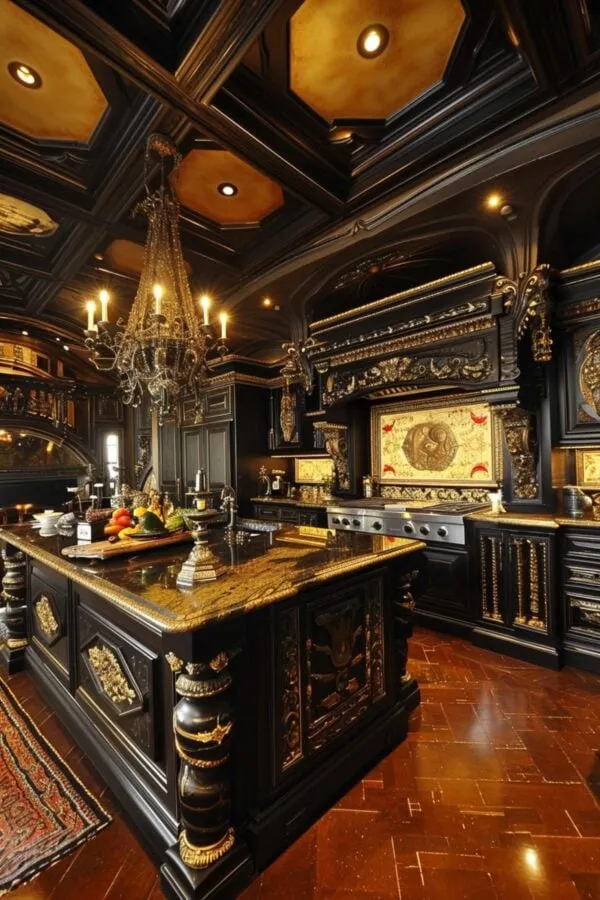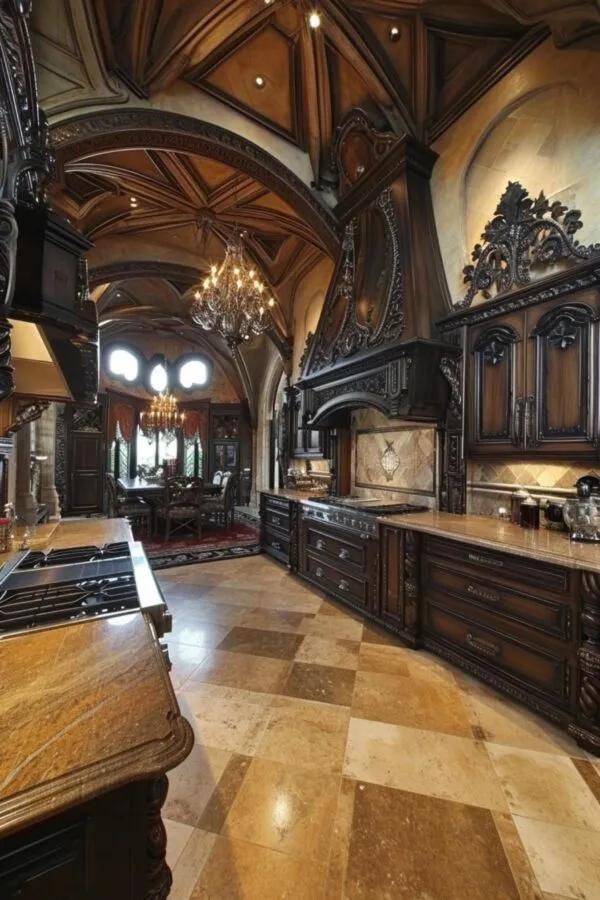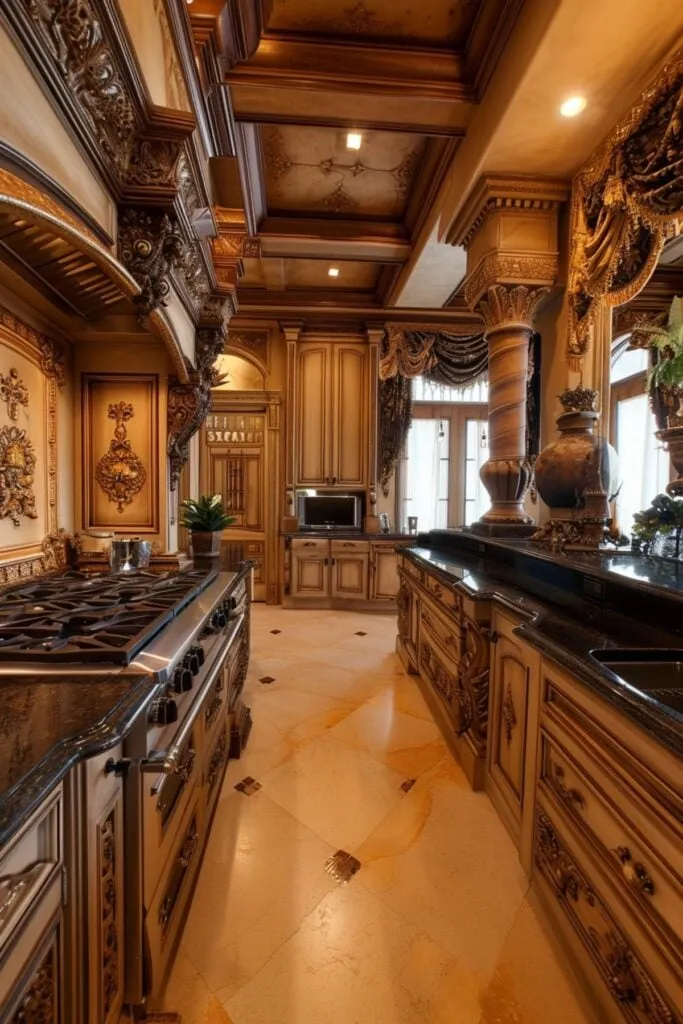Embracing the Gothic Kitchen Aesthetic
The gothic kitchen aesthetic is a captivating design choice that moves away from the minimalist and bright kitchens. It’s about creating a space that evokes a sense of mystery, drama, and historical elegance. This style often incorporates dark colors, intricate details, and a focus on creating a unique ambiance. It’s an excellent choice for those looking to infuse their home with a touch of the extraordinary. The core principle of a gothic kitchen is to transport you to a different era, a time of grand castles and secret chambers. This can be achieved through thoughtful design choices. To fully embrace this aesthetic, one must consider the key elements that define it. These include the color palette, the choice of materials, and the overall atmosphere.
Dark Color Palette and Dramatic Lighting
The heart of a gothic kitchen lies in its color scheme. Deep, rich hues are the foundation of this aesthetic. Think of colors like charcoal gray, deep blacks, burgundy, and forest green. These colors create a sense of depth and mystery, characteristic of the gothic style. However, it’s essential to balance these dark shades with lighter accents to prevent the space from feeling too enclosed. Metallic touches, such as silver or brass, can be incorporated to add a touch of glamour. Lighting is a crucial element. It is important to play with lighting to set the mood and highlight key features. Chandeliers with intricate designs and wrought iron fixtures are ideal. Layering different types of lighting, such as ambient, task, and accent lighting, will create depth and ensure the kitchen is functional and visually appealing. Consider using dimmers to adjust the lighting levels and create the desired atmosphere.
Incorporating Dark Wood and Antique Finishes

Dark wood is a key material in gothic kitchens. It provides a sense of solidity, tradition, and visual interest. The natural grain of the wood and its rich color add warmth and character to the space. Consider using dark wood for cabinetry, flooring, and other architectural details. Antique finishes contribute significantly to the gothic aesthetic. These finishes evoke a sense of history and timelessness, aligning with the gothic style. You can incorporate antique elements in several ways, from hardware to furniture. For instance, consider cabinet knobs and pulls with intricate designs. Antique or vintage furniture pieces, like a rustic dining table or a weathered kitchen island, add character and authenticity. The incorporation of these materials and finishes results in a kitchen that feels grounded in history, creating an atmosphere of depth and luxury.
Adding Gothic Kitchen Chairs
The chairs in a gothic kitchen should complement the overall aesthetic, blending style and functionality. Consider chairs with dark wooden frames, intricate carvings, and upholstery in velvet or leather. High-backed chairs can add a sense of drama, while chairs with a more streamlined design maintain the gothic charm. The choice of chairs contributes significantly to the dining area’s overall atmosphere. Consider the materials and craftsmanship when selecting chairs. Wrought iron chairs or chairs with metal accents add authenticity and enhance the gothic style. The upholstery can be a great opportunity to introduce textures and patterns that complement the color palette. Combining different chair styles can add visual interest, but it’s important to maintain a cohesive look. The right gothic kitchen chairs should be visually striking, and they should also be comfortable and functional for everyday use.
Selecting the Right Gothic Kitchen Decor
The choice of decor items can transform a kitchen. These are a critical part in creating a cohesive and authentic gothic space. Decorative elements can range from artwork and statues to functional items like dishware and utensils. Think about incorporating antique or vintage pieces. Consider elements such as candelabras, ornate mirrors, and decorative plates. When selecting decor, aim for items with intricate designs, dark colors, and a touch of mystery. Displaying these pieces carefully adds visual interest and makes the kitchen more captivating. The decor should complement the color scheme and materials used in the kitchen. It should also enhance the historical and dramatic atmosphere that defines the gothic style. These small details can make a huge difference in the overall design.
Accessorizing with Gothic Kitchen Decor

Accessories play a vital role in enhancing the gothic aesthetic. They help create a cohesive design that embodies the gothic style. Choosing the right accessories allows you to inject personality and detail into your kitchen. Incorporate items that reflect gothic design elements. This could include adding antique candlesticks to your countertops or a statement piece. Think about adding decorative trays and bowls, which can be both beautiful and functional. The accessories you choose should complement the overall color palette and materials. Consider using metallic accents, such as silver or brass. Carefully chosen accessories can elevate the design and enhance the drama. When accessorizing, focus on creating a balance between function and style. Each item should contribute to the overall aesthetic. The right accessories will help you achieve a kitchen that is both beautiful and functional.
Themed Gothic Kitchen
When it comes to creating a themed gothic kitchen, focus on a specific sub-genre. Some of the options are Victorian, medieval or even a modern interpretation. Each theme has its unique elements, offering a way to personalize the space. A Victorian-themed kitchen might incorporate elaborate details. This would involve dark wood, intricate carvings, and elegant chandeliers. A medieval-themed kitchen could feature rustic elements, like exposed beams and stone accents. Modern Gothic interpretations balance traditional elements with contemporary design. Regardless of the chosen theme, the goal is to create a cohesive and immersive environment. When planning a themed kitchen, it’s important to be consistent with the design. This approach guarantees that all elements work together to create a unified aesthetic. If you commit to a theme, you can create a space that is both stylish and reflective of your personal interests.
Blending Modernity with Gothic Decor
Combining gothic elements with contemporary design can create a unique and appealing space. This approach balances the traditional charm of gothic style with the functionality of modern design. To achieve this, consider incorporating gothic features. Think of using dark colors. These would be set against clean lines and minimalistic elements. Modern appliances and sleek countertops can contrast traditional cabinetry. The goal is to create a space that is both stylish and practical. It’s about integrating gothic elements. This would involve furniture, lighting, and decor, while maintaining a sense of modern functionality. Consider choosing statement pieces that incorporate the gothic style. By harmonizing these elements, you can achieve a kitchen design. This design will reflect your tastes. This method allows you to showcase your love for the gothic style while maintaining the comfort and convenience of a modern kitchen.
